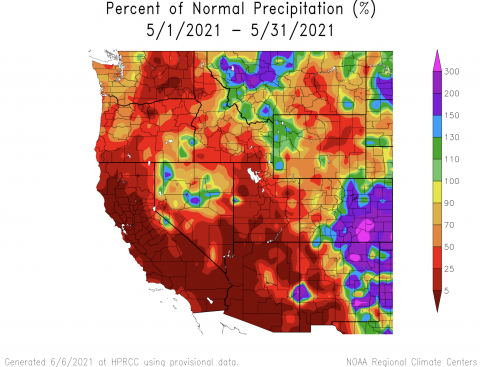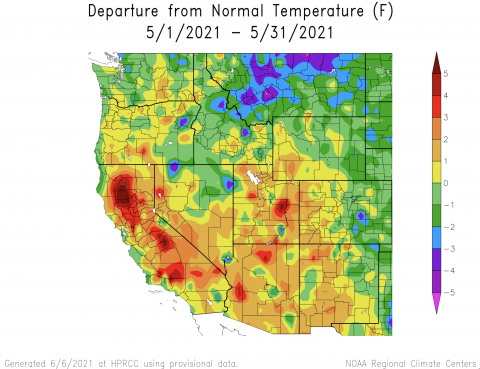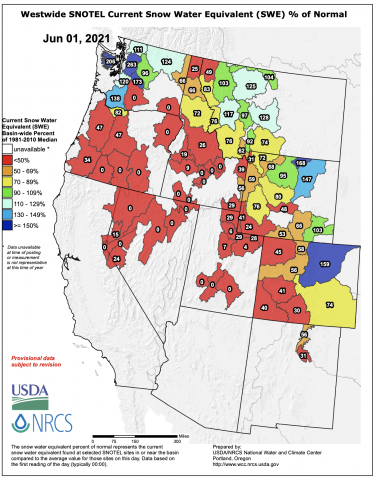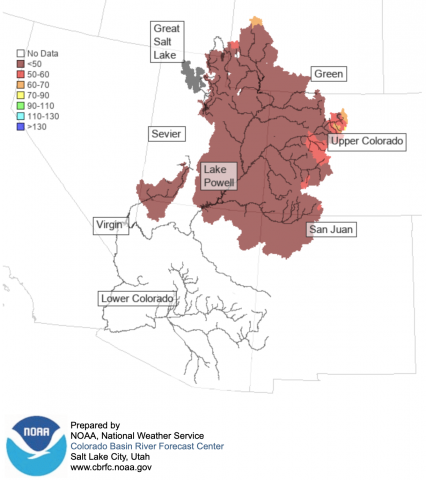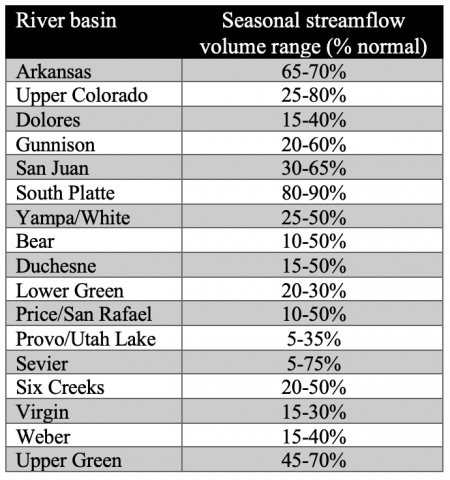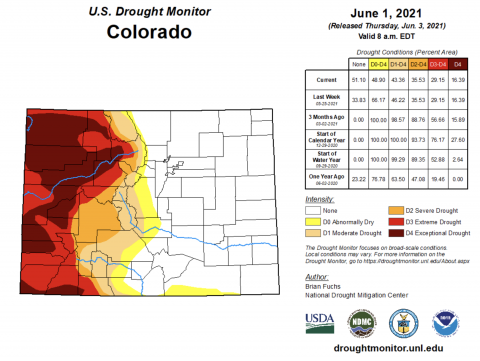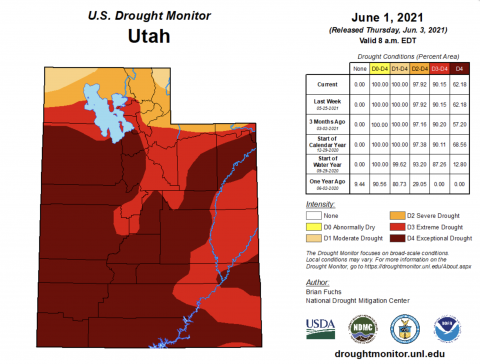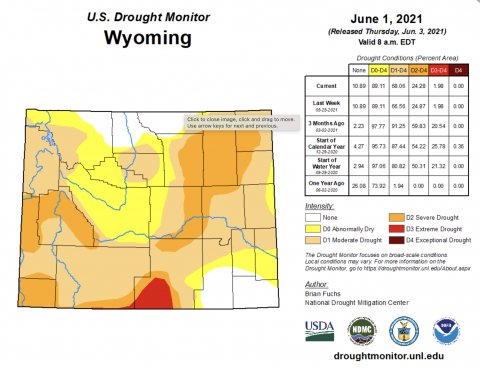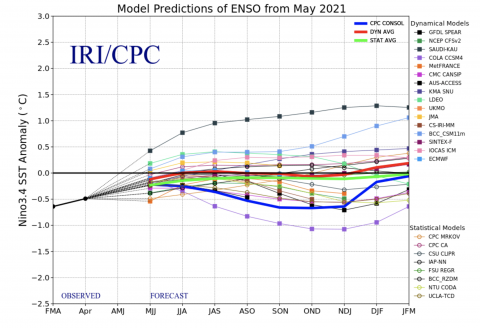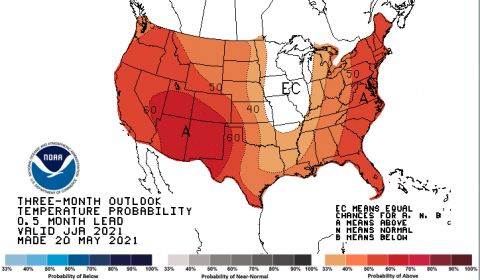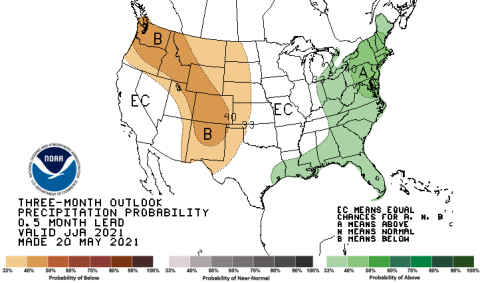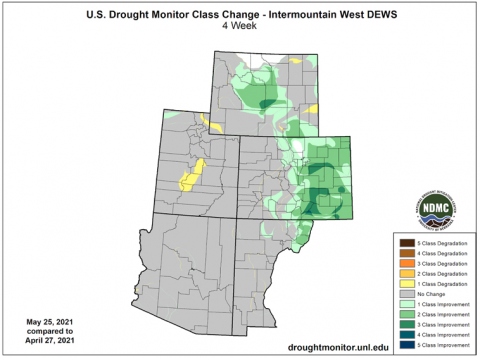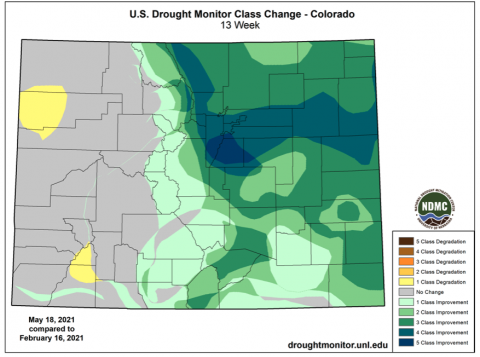June 10, 2021 (UT, WY, CO)
-
During May, much above average precipitation removed drought conditions across Colorado east of the Continental Divide and in southwestern Wyoming. Regional drought conditions persist west of the Divide where D3 and D4 drought cover 90 % of Utah and much of western Colorado. Streamflow forecasts for much of the region are among the five driest on record and the forecasted April-July inflow forecast for Lake Powell is 25% of normal.
-
May yielded drought-busting precipitation amounts east of the Continental Divide in Colorado, especially southeastern Colorado where precipitation was over 200% of normal. Slightly above normal precipitation fell in northwestern Wyoming. Utah was extremely dry in May; nearly the entire state received 50% of normal precipitation and two-thirds of the state received less than 25% of normal May precipitation. Most of Wyoming and western Colorado received slightly below normal precipitation.
-
Temperatures during May were slightly below normal in eastern Colorado and the northeast two-thirds of Wyoming. In Utah, western Colorado and southwestern Wyoming, May temperatures were 1-2 degrees above normal.
-
Regional snowpack conditions were below to much-below normal except for the South Platte River basin in Colorado and Wyoming river basins east of the Continental Divide. On June 1st, snow was completely melted in southern Utah and almost gone along the Wasatch Front and the southern slope of the Uinta Mountains. Snowpack lingers west of the Continental Divide in Colorado, but is less than 50% of normal. Western Wyoming snowpack conditions are a mix of much below normal to slightly below normal.
-
June 1st streamflow volume forecasts from the CBRFC were less than 50% normal for nearly the entire Upper Colorado River and Great Basins. Streamflow volume forecasts in the Upper Colorado River and Great Basins are mostly among the five driest on record. Nearly all of the major reservoirs of the Upper Colorado River basin are forecasted to have less than 50% of normal inflow with Lake Powell forecasted to have 25% of normal inflow (1.8 MAF), a 3% decrease from the May forecast. Streamflow forecasts east of the Continental Divide in Colorado are higher than the rest of the region, but still below normal in the South Platte and Arkansas River basins.
-
Drought conditions during May were very different east and west of the Continental Divide. An extremely wet May completely removed drought conditions east of the Continental Divide in Colorado and in southwestern and north-central Wyoming. Below average temperatures and much above average precipitation drove drought removal. At the end of April, drought conditions covered 89% of Colorado and 85% of Wyoming. By June 1st, drought conditions improved significantly, covering 49% of Colorado and 68% of Wyoming. With the exception of northwestern Wyoming where drought conditions improved by one category, drought persisted west of the Continental Divide and conditions remained largely unchanged. D3 and D4 drought continues to cover 90% of Utah.
-
La Niña conditions, present throughout winter 2021, ended during May as eastern Pacific Ocean temperatures warmed to 0.3° C below normal. Neutral ENSO conditions are expected to continue at least through July. The NOAA seasonal forecast predicts an increased probability for above average regional temperatures during June, except for the Eastern Plains of Colorado. There is also an increased probability for below average June precipitation in Wyoming and northern Colorado and northern Utah. On the three-month timescale, NOAA seasonal forecasts predict an increased probability for above average temperatures across the entire region and below average precipitation except for southwestern Utah.
-
Significant May weather event. An unexpectedly wet May led to dramatic improvements in drought conditions in eastern Colorado and central Wyoming. Drought was completely removed from Colorado east of the Continental Divide and in southwestern Wyoming. The NOAA seasonal forecast for May projected an increased probability for below average precipitation in Colorado and Wyoming, but many areas east of the Continental Divide received 150-300% of normal precipitation. Large areas of eastern Colorado and central Wyoming experienced a two-category improvement in drought conditions during May with isolated areas improving by three drought categories. Since mid-February, above average precipitation caused a five-category improvement to drought conditions in parts of Arapahoe, Jefferson and Douglas Counties, Colorado. A large swath of eastern Colorado experienced a four-category improvement in drought conditions over the same time period.
